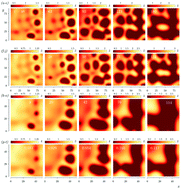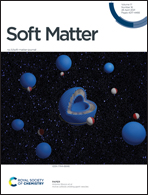Non-linear dynamics and self-similarity in the rupture of ultra-thin viscoelastic liquid coatings
Abstract
The influence of viscoelasticity on the dewetting of ultrathin polymer films is unraveled by means of theory and numerical simulations in the inertialess limit. Three viscoelastic models are employed to analyse the dynamics of the film, namely the Oldroyd-B, Giesekus, and FENE-P models. We revisit the linear stability analysis first derived by [Tomar et al., Eur. Phys. J. E., 2006, 20, 185–200] for a Jeffrey's film to conclude that all three models formally share the same dispersion relation. For times close to the rupture singularity, the self-similar regime recently discovered [Moreno-Boza et al., Phys. Rev. Fluids, 2020, 5, 014002], where the dimensionless minimum film thickness scales with the dimensionless time until rupture as hmin = 0.665τ1/3, is asymptotically established independently of the rheological model. The spatial structure of the flow is characterised by a Newtonian core and a thin viscoelastic boundary layer at the free surface, where polymeric stresses become singular as τ → 0. The Deborah number and the solvent-to-total viscosity ratio affect the rupture time but not the length scale of the resulting dewetting pattern and asymptotic flow structure close to rupture, which is thus shown to be universal. Our three-dimensional simulations lead us to conclude that bulk viscoelasticity alone does not explain the experimental observations of dewetting of polymeric films near the glass transition.



 Please wait while we load your content...
Please wait while we load your content...